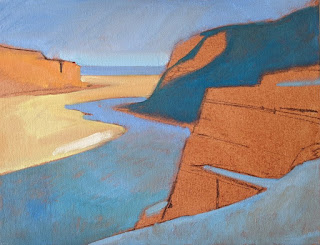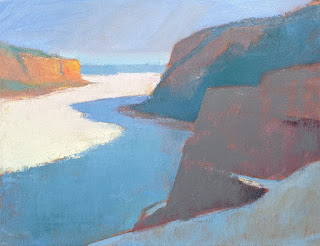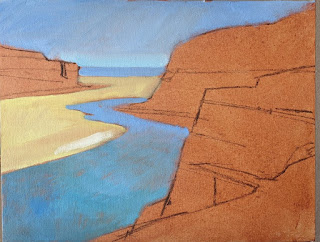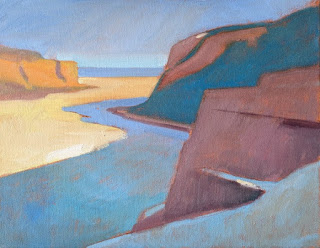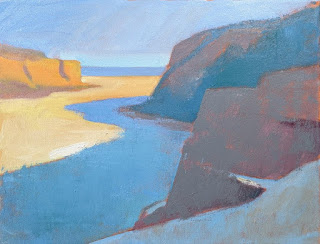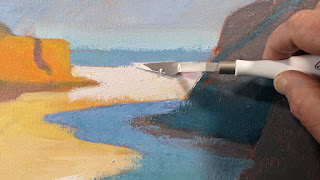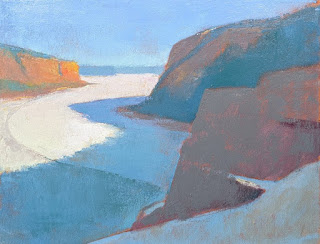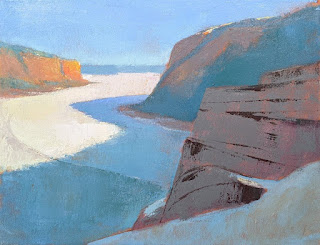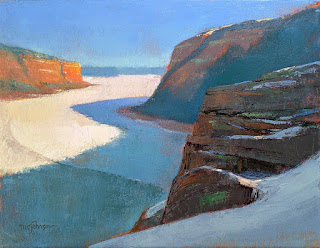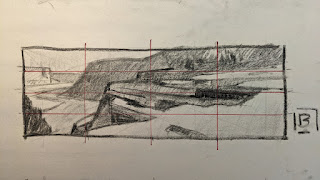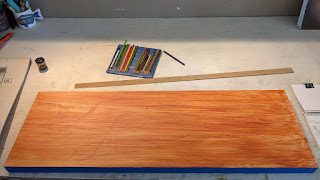“Art by committee” has never worked for me. I dislike getting other people too involved in my creative decisions. Of course, that doesn't mean I won't ask for advice at a critical point. If I'm uncertain, I may seek out one of the master artists I know. And in workshops, if a demonstration is veering into the ditch, I'll ask my students for input. But as the artist, I feel that, ultimately, all decisions are mine.
But once in awhile, I like to ask a larger audience, one that includes people who might say: “I don't know much about art, but I know what I like.” I'm interested to see what appeals to people who aren't artists but who like art, especially if I feel I have multiple options for a problem, and each option seems an equally worthy solution. Sure, I could toss a coin—but I think that asking a larger audience can give me valuable insight.
Not far from my studio, there's a ridge that overlooks the lake. I like to hike up to it for the view. One morning this winter, I went out when the sun was still quite low in the sky. Shadowy blues covered the snowy ridge, but the ice-covered lake and a distant ridge glowed with an incandescent, warm light. I instantly knew I had to paint the scene—but how best to evoke the feeling I had felt on that ridge?
The easiest part of the answer was color harmony—dominant cool blues and greens with a punch of hot red-orange. Nothing else would work. The harder part was design. Design sets the stage for color, and I needed to address that first. How could I give the viewer a sense of scale and the feeling of being up high?
In the studio, I always take my time exploring design options. This time was no different. I put a big sheet of newsprint up on the easel and began sketching out some ideas in vine charcoal. These explorations gave me some exciting possibilities—but I didn't believe any one rose above the others. I felt each could make a good painting, yet I couldn't decide. The only thing I could decide on was a long format, a 12x36 (1:3 aspect ratio.) So, I put the question to my followers on Facebook and Instagram and asked them to vote:

Design "A" got many votes and seemed to appeal to people without question.
Design "B" got a few more votes than “A." However, the tree in the bottom left was a problem for some. It obstructed their visual journey into the distance. Because of this, one person remarked that, if the distant view of the lake was my subject, “A” would be the right choice; but if I wanted to keep the viewer in the foreground cliff area, then “B” was the right choice. (The lone tree and the foreground cliff together serve as a fence for the eye.)
Design "C" got the least number of votes. But here, the subject was clearly the foreground or middle ground.
My personal choice was “B,” the result of which you can see at the top of this post. Although I understood what people were saying about the tree on the left, I was looking at the design in a larger version—4x12—than what most were seeing on their computer screens. At that size, the tree was less significant and, in my mind, wasn't an obstacle. For me, it served to keep the viewer's eye from wandering out the bottom left corner and also helped with the feeling of the viewer being high up.
Once I scaled up my 4x12 design to my 12x36 cradled panel, the tree became even less of an obstacle. Lightening the tree a bit in the painting and darkening the ice behind it reduced the contrast slightly, which further reduced the tree's prominence. The eye could now follow the little accents of light in the shadows out to the ice and beyond, settling finally on the distant cliff. I also chose to tone down the “incandescence” of that cliff, allowing the viewer to enjoy the closer cliff a little longer.
After painting “B,” I decided to tackle a version of the view without the tree. I wanted to emphasize the lake this time, so rather than trying for a long format and including much of the foreground cliff, I narrowed the view, going with a 14x18 (7:9 aspect ratio) and leaving out the tree. I think it works well, too.
Input from my larger audience helped with making sure in “B” that the left-corner tree was “tweaked” to serve my purpose correctly, and it also encouraged me to try a version of “A.” Without that input, I would forever be second-guessing myself on this project.

